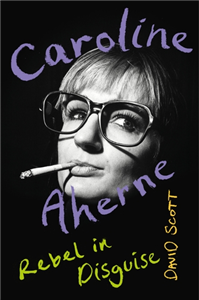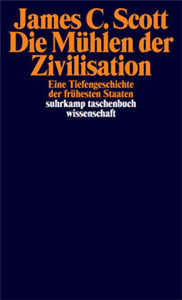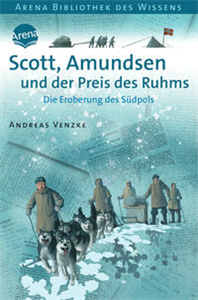Your Search Results
-
Sarah McKenzie Literary Agency
Sarah McKenzie Literary Management provides advice, advocacy and representation to Australian authors. As well as representing best-selling authors with a proven track record, we love to identify and champion talented new and emerging writers of children's fiction, commercial fiction, literary and narrative nonfiction.
View Rights Portal
-
Promoted ContentBiography & True StoriesMay 2026
Caroline Aherne
Rebel in disguise
by David Scott
A thoughtful exploration of the work of this unique comedian and writer. Caroline Aherne was one of the most influential and beloved of British comedians. In this book David Scott explores Aherne's comedic artistry and creative legacy, focusing on her iconic characters and ground-breaking TV shows. Scott dives into Aherne's most beloved creations, from the sharp-tongued Mrs Merton to the quietly revolutionary The Royle Family. Drawing on the tales of collaborators and telling behind-the-scenes stories, he provides an intimate glimpse into the creative processes that brought these iconic works to life. At the same time, he examines the social and cultural influences that shaped Aherne's work, from the rich traditions of Northern working-class humour to the experiences of Irish migrants. Aherne's work is celebrated for its sharp wit, warmth and ability to find comedy in adversity. This book offers an exploration and celebration of one of comedy's most inventive minds, revealing how she reshaped the British comedy landscape.
-
Promoted ContentJune 2024
Key Questions in Wildlife & Nature Conservation Law
A study and revision guide
by Paul A. Rees
Law plays an essential part in the conservation of wildlife and ecosystems. The study of wildlife and nature conservation law is an important component of a wide range of programmes of study including wildlife conservation, environmental management and environmental law. This book is a study and revision guide for students following such programmes. It contains 600 multiple choice questions (and answers) set at three levels - foundation, intermediate and advanced - and grouped into 10 major topic areas: 1. Principles of Wildlife and Nature Conservation Law 2. History of Wildlife and Nature Conservation Law 3. Species Protection and Exploitation I - EU and International Law 4. Species Protection and Exploitation II - National Laws 5. Protected Areas and Habitats I - EU and International Laws 6. Protected Areas and Habitats II - National Laws 7. Planning, Pollution, Restoration and Conservation Funding 8. Wildlife Trade, Animal Collections and Alien Species 9. Wildlife Law Enforcement and Penalties 10. Legal Texts This book has been produced in a convenient format so that it can be used at any time, in any place. It allows the reader to learn and revise the meaning of terms used in wildlife and nature conservation law and study the role of legislation at national, European Union (EU) and international level in the protection of individual species, habitats and landscapes. It uses examples from a wide variety of taxa, habitats and protected areas selected from a range of jurisdictions from the United Kingdom, the United States and Australia to Antarctica and the High Seas. Topics include the control of hunting, the conservation of trees and forests, the protection of National Parks and wilderness areas, wildlife trade and the organisations involved in the enforcement of wildlife laws. The structure of the book allows the study of one topic area at a time, progressing through simple questions to those that are more demanding. Some of the questions require students to use their knowledge to interpret information provided in the form of photographs and legal texts.
-
 Trusted Partner
Literature & Literary StudiesAugust 1998
Trusted Partner
Literature & Literary StudiesAugust 1998Pulp
Reading popular fiction
by Scott McCracken
Pulp brings together in one volume chapters on the best seller, detective fiction, popular romance, science fiction and horror. It combines a lucid and accessible account of the cultural theories that have informed the study of popular fiction with detailed readings of Jackie Collins, Jilly Cooper, Colin Dexter, William Gibson, Stephen King, Iain Banks, Terry McMillan and Walter Mosley. Scott Mc Cracken argues that popular fiction serves a vital function: it provides us with the means to construct a workable sense of self in the face of the disorientating pressures of modernity. ;
-
 Trusted Partner
Insecticide & herbicide technologyDecember 2000
Trusted Partner
Insecticide & herbicide technologyDecember 2000Evaluating Indirect Ecological Effects of Biological Control
by Edited by Eric Wajnberg, John K Scott, Paul C Quimby
A major concern for biological control has always been the risk of indirect unwanted effects on the ecology of other organisms. Our understanding of the ecological and evolutionary processes underlying these effects has until now been limited and experimental methods sometimes lacking. This book presents the key papers from of the first International Organisation for Biological Control global symposium, held in Montpellier, France, in October 1999. It addresses the issues and concerns involved in biological control, and assesses the current status of evaluation of the ecological effects.
-
 Trusted Partner
October 2020
Trusted Partner
October 2020Die Mühlen der Zivilisation
Eine Tiefengeschichte der frühesten Staaten
by James C. Scott, Horst Brühmann
Wie selbstverständlich gehen wir davon aus, dass die neolithische Revolution, in deren Verlauf Nomaden zu Ackerbauern und Viehzüchtern wurden, ein bedeutender zivilisatorischer Fortschritt war. James C. Scott entwickelt in seinem provokanten Buch eine ganz andere These: Die ersten Staaten entstanden aus der Kontrolle über die Reproduktion und errichteten ein hartes Regime der Domestizierung und Unterwerfung, das Epidemien, Ungleichheiten und Kriege mit sich brachte. Einzig die »Barbaren« – die heimlichen Helden dieses Buches – haben sich der Sesshaftigkeit sowie den neuen Besteuerungssystemen verweigert und sich damit gegen die Mühlen der Zivilisation gestemmt.
-
 Trusted Partner
October 2017
Trusted Partner
October 2017Zerbrochene Länder
Wie die arabische Welt aus den Fugen geriet
by Scott Anderson, Paolo Pellegrin, Laura Su Bischoff
»So ist also die Frage beantwortet, ob man das aktuelle Chaos in der arabischen Welt in einem einzigen journalistischen Stück erfassen kann. Man kann. Scott Anderson kann es sogar grandios.« Die Zeit »Die hellsichtigste, kraftvollste und menschlichste Erklärung dessen, was in der Region passiert ist, die Sie jemals lesen werden.« The New York Times Magazine »Manchmal fließt die Geschichte der Menschheit bedächtig vor sich hin, manchmal bewegt sie sich sehr schnell.« Diesen Satz formulierte Muammar al-Gaddafi 2002 gegenüber Scott Anderson. Tatsächlich hat sich die Geschichte im Nahen Osten überschlagen, seit die USA 2003 im Irak einmarschiert sind: 2011 weckte der Arabische Frühling Hoffnungen, doch bald versanken Länder wie Syrien und der Irak im Chaos, von dem wiederum der Islamische Staat profitierte. Millionen Menschen flohen aus Syrien in Nachbarstaaten und nach Europa. Anhand der Erlebnisse von sechs Menschen schildert Anderson die Geschichte einer zerbrechenden Region. Er begleitet den jungen Iraker Wakaz, der sich vorübergehend dem IS anschließt, Laila, die Witwe eines prominenten ägyptischen Menschenrechtsanwalts, deren Sohn innerhalb kurzer Zeit von drei Regimes inhaftiert wird, und Majd, den seine Flucht von Homs über das Mittelmeer bis nach Dresden führt. Illustriert wird Andersons Großreportage mit Aufnahmen des renommierten Fotografen Paolo Pellegrin. Ein einmaliges zeitgeschichtliches Dokument.
-
 Trusted Partner
Trusted Partner
-
 Trusted Partner
November 2011
Trusted Partner
November 2011Der große Gatsby
by Francis Scott Fitzgerald, Reinhard Kaiser
New York in den 'Goldenen Zwanzigern': Man tanzt Charleston und Black Bottom und begeistert sich für Duke Ellington und Louis Armstrong. Der geheimnisumwitterte Jay Gatsby hat alles, was man mit Geld kaufen kann, und führt ein Leben im Überfluß. Die rauschenden Feste auf seinem märchenhaften Anwesen auf Long Island sind berühmt und ein beliebter Treffpunkt der New Yorker High-Society. Dennoch ist Gatsby ein Einzelgänger, der zurückgezogen lebt. Niemand weiß etwas über seine Herkunft oder welchen dubiosen Geschäften er seinen Reichtum verdankt. Die Geschichte von Jay Gatsby, dem einsamen Millionär, der seiner längst verlorenen Liebe nachjagt, ist einer der größten und meistgelesenen Klassiker der amerikanischen Literatur. F. Scott Fitzgerald, der Dichter der 'Roaring Twenties', erzählt von der Glamourwelt der Reichen und von der Oberflächlichkeit und Sinnlosigkeit des mondänen Lebens. In der glanzvollen Neuübersetzung von Reinhard Kaiser ist dieser Roman neu zu entdecken - in seiner Dramatik, seiner Tragik, seiner Eleganz und nicht zuletzt auch in seiner Komik.
-
 Trusted Partner
Geography & the EnvironmentOctober 2021
Trusted Partner
Geography & the EnvironmentOctober 2021Key Questions in Hydrology and Watershed Management
A Study and Revision Guide
by Leon Bren, Patrick Lane
This book provides a series of exercises of various types covering matters of hydrology and watershed management. The exercises include true/false questions, multiple choice questions, and numeric, graphical, and analytical exercises. The questions draw on the basic disciplines of hydrology and physics, with some stress placed on correct or appropriate units. The questions reflect the authors' many years of teaching watershed management at undergraduate and graduate levels. Questions cover: 1. Terminology and measurement of flow (and units) 2. Quantifying stream networks 3. Concepts of water balance and evapotranspiration 4. Slope recharge, groundwater hydrology, and water-table/phreatic aquifers 5. Single and paired watershed experiments 6. Impacts of fires on watersheds 7. Concepts and measurements of water quality 8. Flooding forests 9. Valuation of water 10. Protection of forest stream by buffers 11. Urban watershed concepts The book is self-contained, and designed to be used at any time in any place, either for revision or as source material for teaching. The work is graded so that easier questions are presented early, followed by harder questions. Answers are concise but contain enough information to help students study and revise on a topic-by-topic basis. The book concludes with suggestions for student exercises and projects and is an invaluable resource for both students and instructors.
-
 Trusted Partner
Forestry & silviculture: practice & techniquesDecember 2000
Trusted Partner
Forestry & silviculture: practice & techniquesDecember 2000Forests and Landscapes
Linking Ecology, Sustainability and Aesthetics
by Edited by Eric Wajnberg, John K Scott, Paul C Quimby
Forests are an important component in the visual appeal of landscapes. There is an increasing recognition of the importance of this subject among foresters and environmental scientists. Increasingly, forest resource managers must consider both the aesthetic consequences of timber harvesting operations and management plans and public perceptions of the sustainability of forest eco-system management.Written by world class authorities this book is the first to address this subject area. It consists of 17 chapters and is divided into six parts. The interdisciplinary nature of the book brings together not only foresters and ecologists, but also landscape architects, psychologists and philosophers. Contributors are leading research workers in their subjects, from Canada, the USA and UK.
-
 Trusted Partner
October 2011
Trusted Partner
October 2011Der große Gatsby
by Reinhard Kaiser, F. Scott Fitzgerald
New York in den »Goldenen Zwanzigern«: Man tanzt Charleston und Black Bottom und begeistert sich für Duke Ellington und Louis Armstrong. Der geheimnisumwitterte Jay Gatsby hat alles, was man mit Geld kaufen kann, und führt ein Leben im Überfluß. Die rauschenden Feste auf seinem märchenhaften Anwesen auf Long Island sind berühmt und ein beliebter Treffpunkt der New Yorker High-Society. Dennoch ist Gatsby ein Einzelgänger, der zurückgezogen lebt. Niemand weiß etwas über seine Herkunft oder welchen dubiosen Geschäften er seinen Reichtum verdankt. Die Geschichte von Jay Gatsby, dem einsamen Millionär, der seiner längst verlorenen Liebe nachjagt, ist einer der größten und meistgelesenen Klassiker der amerikanischen Literatur. F. Scott Fitzgerald, der Dichter der »Roaring Twenties«, erzählt von der Glamourwelt der Reichen und von der Oberflächlichkeit und Sinnlosigkeit des mondänen Lebens. In der glanzvollen Neuübersetzung von Reinhard Kaiser ist dieser Roman neu zu entdecken - in seiner Dramatik, seiner Tragik, seiner Eleganz und nicht zuletzt auch in seiner Komik.
-
 Trusted Partner
Humanities & Social SciencesJune 2005
Trusted Partner
Humanities & Social SciencesJune 2005Reading Walter Benjamin
Writing through the catastrophe
by Richard Lane
'Reading Walter Benjamin' explores the persistence of absolute in Benjamin's work by sketching-out the relationship between philosphy and theology apparent in his diverse writings, from the early youth-movement essays to the later books, essays and fragments. The book examines Benjamin from two main perspectives: a history-of-ideas approach situating Benjamin in relation to the new German-Jewish thinking at the turn of the twentieth-century, as well as the German youth movements, Surrealism and the 'Georgekreis'; and a conceptual approach examining more critical issues in relation to Benjamin and Kant, modern aesthetics and narrative order. Chapters cover: 'Kulturpessimismus' and the new thinking; metaphysics of youth: Wyneken and 'Rausch'; history: surreal Messianism; Goethe and the 'Georgekreis'; Kant's experience; casting the work of art; disrupting textual order; and exile and the time of crisis. The book uses new translations of Benjamin's essays, fragments and his 'Arcades Project', and makes substantial reference to previously untranslated material. Lane's text allows the non-specialist entry into complex areas of critical theory, simultaneously offering original readings of Benjamin and twentieth-century arts and literature. ;
-
 Trusted Partner
Geography & the EnvironmentAugust 2022
Trusted Partner
Geography & the EnvironmentAugust 2022Key Questions in Environmental Toxicology
A Study and Revision Guide
by J P F D'Mello
Key Questions in Environmental Toxicology is designed as a self-study tool for undergraduate students. Questions review the origin, characterization and environmental distribution of major pollutants, followed by their absorption and metabolic disposition in living organisms. They address implications for the development of cancer, cardiovascular disease, pulmonary dysfunction and neurological conditions in relation to gaseous pollutants, particulates, persistent organic compounds and radioactive emissions, then cover the impact of pollutants on biodiversity, food safety, and water contamination. This book: - Covers toxicology from human morbidity, ecological impact and biodiversity perspectives, and emphasises the impact of diverse organic pollutants in worsening these interconnected phenomena, leading to wider environmental emergencies; - Provides a selection of fill-in-the-gap, multiple choice and short answer question types for students to vary their learning and enhance motivation; - Includes full answer rationales, allowing students to gain true insight into the subject. Providing support to programmes across environmental science, ecology and human health, and covering all the major biological toxins and pollutants as well as unintended consequences of actions designed to improve outcomes, this book may be used in conjunction with the companion volume Introduction to Environmental Toxicology.
-
 Trusted Partner
Tourism industryMay 2011
Trusted Partner
Tourism industryMay 2011Tourist Destination Governance
Practice, Theory and Issues
by Edited by Eric Laws, Harold Richins, Jerome F Agrusa, Noel Scott.
Managing and co-ordinating tourism in a destination requires the organisation and co-operation of a large number of sectors, businesses, local authorities and individuals. Since tourism is an important driver in many economies destination governance in tourist destinations needs to be done well, to achieve economic aims and maintain sufficient infrastructure. This book provides a guide to the theoretical and methodological understanding of how to implement best practice governance procedures, with case studies illustrating good performance.
-
 Trusted Partner
Humanities & Social SciencesMay 2011
Trusted Partner
Humanities & Social SciencesMay 2011Constitutions and political theory
Second edition
by Jan-Erik Lane
Since constitutional arrangements are what make politics work, they are a central concern of political theory. This book, now completely updated, was the first comprehensive exploration of the political theory of constitutions. Jan-Erik Lane begins by examining the origins and history of constitutionalism and answers key questions such as: what is a constitution? Why are there constitutions? From where does constitutionalism originate? How is the constitutional state related to democracy and justice? Constitutions play a major role in domestic and international politics in the early 21st century and an updated version of this classic textbook will introduce students to a number of different areas - theoretical, empirical and moral - which will aid their understanding of this important topic. ;
-
 Trusted Partner
January 2011
Trusted Partner
January 2011Scott, Amundsen und der Preis des Ruhms
Die Eroberung des Südpols
by Venzke, Andreas / Illustriert von Fredrich, Volker
-
 Trusted Partner
Science & MathematicsMarch 2022
Trusted Partner
Science & MathematicsMarch 2022Key Questions in Urban Pest Management
A Study and Revision Guide
by Partho Dhang, Philip Koehler, Roberto Pereira, Daniel D Dye II
Urban pests are common all over the world. These include cockroaches, flies, mosquitoes, bed bugs, ticks, fleas, ants, termites, rodents and others. These pests thrive in human structures, where there is food, warmth and places to hide. Urban pests are one of the leading causes of illnesses in humans due to allergies, bites, food contamination and phobias. They can also cause significant damage to property and structures. Knowledge and training in this field is vital for professional and trainee pest managers. This book is specifically intended to provide an aid to such candidates. The book contains 500 multiple-choice questions (and answers) grouped into the following major topic areas: · The history of urban entomology · Household pests · Cockroaches · Flies · Mosquitoes · Bed bugs · Termites · Sporadic pests · Stored product pests · Vertebrate pests · Pesticides and pesticide formulations · Handling pesticides · Integrated Pest Control Produced in a convenient format that can be used at any time in any place, the book allows the reader to learn and revise the subject and much more. Its structure allows the study of one topic area at a time, progressing through a simple introduction followed by key revision questions, many of which require students to use their practical knowledge. The answers to each of the questions are provided at the end with short explanations wherever appropriate.
-
 Trusted Partner
Trusted Partner
-
 Trusted Partner
Trusted Partner
-
 Trusted Partner
Business, Economics & LawOctober 2020
Trusted Partner
Business, Economics & LawOctober 2020The Elephant Tourism Business
by Eric Laws, Noel Scott, Xavier Font, John Koldowski
Elephant tourism is a growing attraction in many countries across Asia and Africa and is popular with tourists from many origins. As elephants are no longer used in the logging industry in Asia, elephant tourism has grown rapidly, providing the only viable way that elephants and their owners can generate income. Old logging camps were developed into sanctuaries for some elephants, but many other camps were established as entertainment centres, with various welfare issues resulting for the elephants and their mahouts. The profits from elephant tourism in Asia have encouraged African operators to follow a similar business model. This book draws attention to the need for a comprehensive and rigorous focus on local solutions to improve the welfare of captive elephants and tourists' experiences of elephant tourism, to the benefit of local communities by: Critically reviewing recent research into elephant tourism Providing contemporary analytical case studies of elephant tourism policy and practice Identifying future research priorities The Elephant Tourism Business will contribute to a better understanding of how elephant tourism is organised, regulated and promoted, both in tourist origin countries and in elephant areas. It identifies priorities for future research into elephant tourism and provides a unique, authoritative resource for researchers, elephant managers and administrators, and tourism managers in this developing area of international concern. The book will be of interest to academics and practitioners with backgrounds in conservation, environment, tourism and veterinary sciences.































